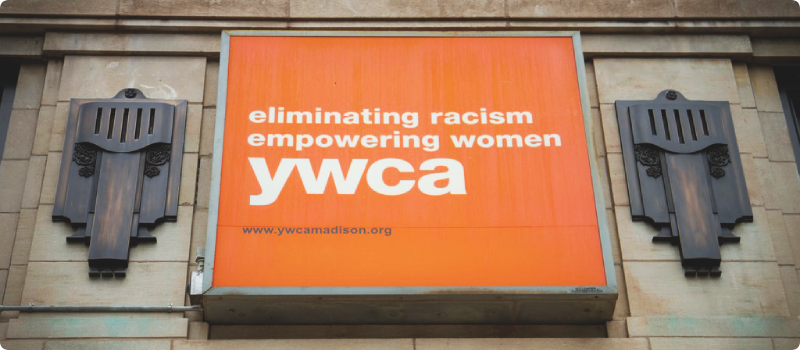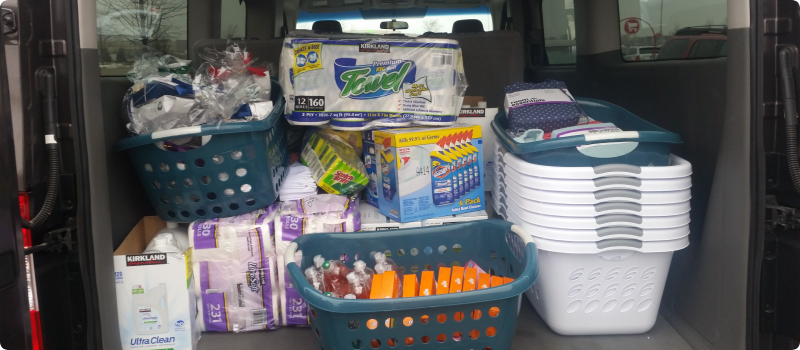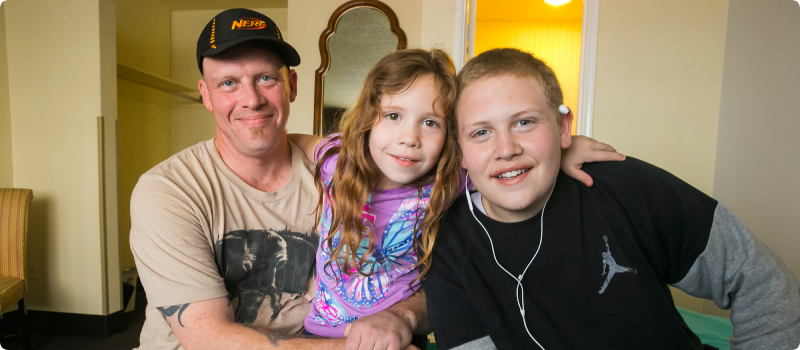How to support your local shelter and fight homelessness in your community
Updated April 26, 2022 . AmFam Team
Whether it’s the season of giving or not, it’s always a great time to help give back to individuals and communities in need. But what if hurdles like a global pandemic get in the way? While there might be a few changes and extra precautions, people still need your help — now more than ever.
About our featured shelters
To find out how individuals and companies can still make a difference during this time of social distancing, we spoke with three organizations committed to eliminating homelessness and housing insecurity in their local communities: YWCA Madison in Wisconsin, Youth Emergency Services and Shelter in Iowa and Mary’s Place in Washington.
YWCA Madison (Opens in a new tab) is a nonprofit organization in Wisconsin that focuses on four key areas: housing and shelter, jobs and transportation, race and gender equity and restorative justice with around 20 different programs. For the YWCA Madison, we spoke with Jael Currie, the housing director, and Jill Pfeiffer, the development and marketing director.
Youth Emergency Services and Shelter (YESS) (Opens in a new tab) is the largest shelter in Iowa, which offers emergency shelter for more than 500 children and a range of other services, including health skill-building programs, mental health programs, counseling, respite care and more. We spoke with Brette Puhl, community outreach manager; Celia Turner, communication coordinator; and Chris Andersen, director of philanthropy and community partnerships.
Mary’s Place (Opens in a new tab), a nonprofit in Washington state, provides safe, inclusive shelter and services that support women, children and families on their journey out of homelessness. The organization operates five emergency family shelters, provides health services, helps families find long-term housing solutions, offers employment assistance and so much more. Here we spoke with Linda Mitchell, the chief communications officer.

Though these organizations are in different parts of the country and have different approaches to providing aid to others, they have two critical things in common: The pandemic is hitting them harder than ever, and they need your help to provide safe, secure housing for all.
The pandemic has put a considerable strain on the economy and many jobs have been lost — which led to an increase in homelessness. Many are struggling to make rent or mortgage payments and look to services like these for support.
A lot of shelters are keeping their doors open, but they face struggles with increased need of shelter in areas that already had high rates of homelessness. And social distancing creates an even larger challenge as shelters work to keep staff, volunteers and visitors safe and healthy. Often that means operating at lower capacities or installing extra precautions, such as plexiglass shields, to help prevent transmission of the virus or other infectious diseases.
When we asked Celia of YESS in Iowa how the pandemic has impacted their community, she replied, “Well how hasn't the pandemic affected us? It's really affected us in so many ways.”
She continued, saying, “Not only in our facility and the protocols that we now as staff and our kids follow to make sure that everything is functioning, but there's also no doubt that this pandemic has prompted a mental health crisis. So the mental health agency side of our organization is really being impacted by this. We’re trying to take this chance to realign ourselves with the people that we're trying to serve. Now, more than ever, the community needs this place as a mental health provider and needs us for that support.”

Ways to support shelters and housing agencies
So how can you help shelters during a pandemic? We’ll discuss what you can and should donate, what you should not, how to volunteer during the pandemic and how your organization can help these housing solutions even more.
Are you ready to learn how to make a meaningful difference? Let’s get started!
How to make donations to a homeless shelter during the pandemic
The pandemic is also hurting those that do not face homelessness. Community members may be less likely to make large donations due to the uncertain economy and money feeling a bit tighter.
Linda from Mary’s Place offered a solution for those that want to donate but can only offer small contributions: “We’re calling for rapid response funds to help a family overcome small financial barriers. With a little bit of a financial assistance, it could be a $25 gas card to get to a job or a car repair, a plane or bus ticket to reunite them with family or paying down last month’s debt — whatever it takes to get them quickly back into housing.”
If you’re looking to give money to a shelter, first check out their website for a secured online donation — it’s a great way to donate without having to handle physical money.
If they don’t have an online portal for donations or you’d rather keep it old school, you can mail in a check. Just make sure to verify the address and name before sending the check for your donation!
While financial contributions will always be welcomed and appreciated, there are other creative ways to donate to these worthy causes.

Best items to donate to local shelters during the pandemic
When it comes to donations, especially during a pandemic, the number one rule is to check with the shelter before donating. It’ll save time for you and the staff at the shelter if you confirm items that are fair game to donate. Each shelter will have different needs, especially in different season and climates, so it’s always good to check in with your desired shelter to donate.
These shelters offer wish lists on their websites for people to donate things the shelter urgently needs. Wish lists are checked and updated regularly, so make sure to keep up to date with the shelter’s most pressing needs. You can find the wish list for YWCA Madison’s housing programs here (Opens in a new tab), the list for Mary’s Place here (Opens in a new tab) and the list for YESS here (Opens in a new tab).
While every shelter has different needs, if you’re looking for ideas of items to donate during the pandemic, we’ve combined a list of items the shelter representatives told us are in high demand.
Here are some donation item ideas:
- Cleaning supplies
- Face masks
- Diapers
- Underwear of all sizes (brand-new and unused)
- Twin blankets and sheets for shelter beds
- Seasonally appropriate clothing
- Toys for a large age range for families and kids
Donation items that homeless shelters may not be able to accept
Food. Check with a shelter or housing agency before donating items like food, even canned items. Look for a local food bank, food pantry or food drive if you have food you’d like to donate.
Personal items. While donating your things may help you clear your closet or shelves and give back to the community, Jael from YWCA Madison cautioned that items donated that feel too personal can hinder the family’s ability to find their own unique favorite things.
“When we donate things, a lot of us think about what we would like or what we would like to give to others, but a lot of times that can take away the autonomy of families,” she explained. “We always encourage gift cards. We understand that it sometimes takes away the personal connection that folks who are donating are seeking, but it empowers our families to buy what they need for themselves instead.”
Used fabrics. Many shelters would prefer new, versus used, clothes, towels or other fabric items.
“As a general rule for us, we typically don't like to accept anything used, like used clothing, used shoes or used bath or wash towels. We really prefer that those be new,” said Brette from YESS. “A lot of times, these kids coming into a shelter have never had anything that is just their own, so it’s really cool for us to be able to give them something brand new when they arrive. It is such a seemingly small thing, but it's huge for these kids, so anytime we are able to give them something brand new — that’s just for them — is ideal.”
If you do have old clothes you’d like to donate, look for clothing drives or clothes bins. You can also look to donate used fabrics to organizations that can make them into recycled new clothing.
How to volunteer with a homeless shelter
Shelters are handling volunteers during the pandemic differently. Some can offer volunteers virtual work, some have closed their doors to volunteers entirely and others are still having volunteers come in with extra safety precautions. Make sure to check your local shelter’s website or give them a call to find out how they’re handling volunteers if you’re interested.
Some organizations like the YWCA Madison may have limited shelter volunteers due to COVID-19, but they are currently in need of housing program volunteers.
“We do have volunteer needs in our housing department,” explained Jael. “This area is where we always have needs because it's based upon a volunteer model in our children's program. We provide social and developmentally appropriate opportunities for kids as young as infants, usually up to 12 or 13, but we also have older kids involved.”
“The program is run by a staff member who coordinates it, but volunteers actually staff it so the program can run,” she continued. “So, that is a current volunteer need that wouldn't directly benefit shelter only, but it would benefit children that live in our building downtown.”
If your shelter does have in-person volunteering, requirements differ by the shelter, and they might also change depending on what type of volunteering you want to do.
“Restrictions depend on the volunteer tasks that they're coming in to do, and we have a pretty lengthy volunteer process or application process for our volunteers, as you can imagine,” shared Brette as she walked us through the process. “We want to be very aware and cognizant of who is in our shelter and around these kids. Depending on how closely these volunteers will be working with the kids, we’ll run a background check on each volunteer as well.”
Linda also reminds people considering volunteering that they can do so emphasizing their strengths, “I always remind people that volunteering can include a wide variety of skills,” said Linda. “There are plenty of ways to support shelters other than cash donations. If you have a skill set that you want to share — maybe you’re an artist, teacher or tech savvy — you can teach a class remotely so you can share your expertise or passion.”
Do you have a skill you could share with others? Find opportunities to use your talents to make a big change in someone else’s life.

How can businesses support local homeless shelters?
It’s no wonder why philanthropic efforts are important to companies — customers are proud to do business with them, while employees are reenergized and passionate about working for that company, making a business’s community stronger. Companies can make a difference, no matter how big or small. Whether you are a small business owner or an employee looking for ways to get your company involved, there are great ways to support local shelters.
At American Family Insurance, philanthropic initiatives are at the forefront of our corporate responsibility. In fact, the American Family Insurance Dreams Foundation and American Family Insurance group companies are donating $275,000 in varying amounts to COVID-19 relief funds. In 2020 alone, they donated $50,000 to YWCA Madison in Wisconsin, $40,000 to Mary’s Place in Washington and $10,000 to Youth Emergency Services and Shelter (YESS) in Iowa.
Consider making unrestricted donations
What are unrestricted donations and why do they matter?
Unrestricted donations can be used for any purpose by the nonprofit organization. Jill explained how this helps shelters: “Unrestricted support is very much appreciated. Governmental funding entities, understandably, want to know how they're moving the needle on homelessness. So, we are constantly providing statistics and data to measure our impact. There is a ton of financial reporting with these contracts, and it is always under a time crunch with a very small finance and reporting department. So, when businesses, who can be a little more flexible, ask how they can help I always say that unrestricted dollars are really helpful.”
Jill also recommends that corporations accept narrative-style reporting, which are grant reports that provide a broad yet meaningful picture of how an organization’s donation helped their mission. Many nonprofits simply lack the capacity to do extreme reporting for smaller financial contributions.
Create employee match programs
Match programs can ignite a charitable spark in your employees. In Chris’s experience, “employers may actually have a matching gift fund or matching donation fund that allows employees to double their gift or increase their gift without ever opening their checkbook.”
Allow employees the opportunity to donate to a cause and match their contributions to make an even bigger impact. For example, the American Family Insurance Dreams Foundation allows employees to donate to any 501(c)(3) cause in the United States that serves a social purpose without political or religious agendas.
Attend and sponsor virtual events
A great way to get your team or organization involved with a shelter is to attend or sponsor virtual events. Your local shelter probably has fundraising activities — go check their calendar and find out! Mary's Place hosts a great campaign every year.
“At the end of every year we do a fundraising campaign called No Child Sleeps Outside,” said Linda, “It's a crowdfunding campaign so people and organizations can come together and form teams to set goals and raise money.”
Want to go the extra mile? You can also virtually host your own event as a business or organization for those struggling to interview or find jobs. Host a virtual Lunch and Learn to share about what qualities companies look for in a candidate, what to bring to an interview and how to create a resume.
The best part about virtual events is that you can attend or host one anywhere. Look for a cause that means a lot to you and see if they have an upcoming event your organization can support.

Get creative!
Sometimes, the best way to get people involved in giving back is by providing a fun opportunity to your team.
Jill recommended checking in with a housing agency and creating a drive for your organization: “Sometimes organizations reach out saying they want to help and do something as a collective effort. So, we suggest they do some sort of a fundraising drive.”
“It could be a diaper drive if that's the need at the time, or a cleaning supplies drive if folks want to get together and make an impact in a specific area,” she continued. “I would say it’s important to always check with the organization first and see what their greatest need is at the moment.”
If you’re looking to energize a team to donate to a shelter, consider a fun initiative in the office or wherever you work.
“There are some simple ways to get involved. Large-scale companies to create small opportunities for donations like jeans day on a Friday,” suggested Chris. “It's an opportunity for individuals to be able to donate one or two dollars for a cause and they get to wear jeans for the day.”
If that doesn’t work for your work atmosphere, reach out to the shelter near you — they might have more fun suggestions to get your team excited to give back!
Supporting homeless shelters near you
While volunteering and donations are huge contributions to shelters and housing assistance programs, there are plenty of ways to support shelters near you.
Fight stigmas of shelters
Chris from Youth Emergency Services & Shelter (YESS) shared his feelings about shelter stigmas. “Whether it's a homeless shelter or youth emergency shelter, there's a stigma associated with that,” he said. “Some people just haven’t taken the time to understand the challenges someone facing homelessness battles and what puts them in that position. There’s a need to understand there's a lot more to the story than someone just showing up on the shelter’s doorstep.”
What can you do to help in this case? Be an ally to shelters and those battling with homelessness. Share what you’ve learned about shelters with others and spread awareness of all the good shelters provide.

Advocate for affordable housing
If you don’t feel comfortable going into a shelter during the pandemic, there are powerful ways to help combat homelessness in your area without leaving your home.
One example that Linda shared with us is becoming an advocate. She said, “Advocating for affordable housing is important, particularly permanent supportive housing, since we have a lot of families that need that extra support in housing, but affordable housing in general.”
Consider joining an advocacy committee, calling or writing a letter to your local legislators and community leaders to let them hear your voice and express how ensuring people can access affordable housing matters to their community, and voting for local measures that support affordable housing and other key measures.
Do your research before getting involved
There are some fantastic nonprofits and shelters out there doing good in your community. But, like with any industry, you might need to do some research to find an approach that aligns with your values and passions.
“Different organizations address homelessness differently,” shared Linda. “They're addressing different populations in different ways. They approach the problem by offering different programs and services, all of them are valuable. Just do your research and find one that fits for you.”
Going the extra mile and looking into a shelter before donating ensures your time or money goes into a cause you’re passionate about and aligns with your values.
Brette offered signs to look for before considering donating or volunteering, she advised, “When someone's looking to donate to a shelter or housing assistance program in their local community, ask yourself, ‘Is this the organization I support with my volunteering and donating? What are key signs of a good strong organization and are there any key signs that might make you want to look twice?’ Ask people who’ve worked with them before and do some online research. Look for news articles to see if they are a 501(c)(3).”

Supporting dreams
When it comes to supporting shelters, remember the cardinal rule — always contact the shelter or go to their website first to find out how you can help them with their unique needs. Each shelter has different needs and the sooner you can distinguish the right way you can assist them, the sooner you can change someone’s life.
Supporting shelters is more than supporting a nonprofit — it’s about truly helping people. No matter how you decide to get involved, whether on your own, with friends, colleagues or an organization, what’s most important is getting started. You might be giving up items, time or money, but what you’ll gain in return will be more rewarding than you can imagine.
This article is for informational purposes only and based on information that is widely available. We do not make any guarantees or promise any results based on this information. We are not responsible for the content of any third-party sites that may be linked in this article.

